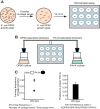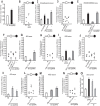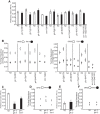Dissecting the signaling mechanisms underlying recognition and preference of food odors
- PMID: 25009271
- PMCID: PMC4087214
- DOI: 10.1523/JNEUROSCI.0012-14.2014
Dissecting the signaling mechanisms underlying recognition and preference of food odors
Abstract
Food is critical for survival. Many animals, including the nematode Caenorhabditis elegans, use sensorimotor systems to detect and locate preferred food sources. However, the signaling mechanisms underlying food-choice behaviors are poorly understood. Here, we characterize the molecular signaling that regulates recognition and preference between different food odors in C. elegans. We show that the major olfactory sensory neurons, AWB and AWC, play essential roles in this behavior. A canonical Gα-protein, together with guanylate cyclases and cGMP-gated channels, is needed for the recognition of food odors. The food-odor-evoked signal is transmitted via glutamatergic neurotransmission from AWC and through AMPA and kainate-like glutamate receptor subunits. In contrast, peptidergic signaling is required to generate preference between different food odors while being dispensable for the recognition of the odors. We show that this regulation is achieved by the neuropeptide NLP-9 produced in AWB, which acts with its putative receptor NPR-18, and by the neuropeptide NLP-1 produced in AWC. In addition, another set of sensory neurons inhibits food-odor preference. These mechanistic logics, together with a previously mapped neural circuit underlying food-odor preference, provide a functional network linking sensory response, transduction, and downstream receptors to process complex olfactory information and generate the appropriate behavioral decision essential for survival.
Keywords: glutamatergic transmission; neuropeptide signaling; olfactory sensory neurons; olfactory sensory signaling; preference of food odors.
Copyright © 2014 the authors 0270-6474/14/339389-15$15.00/0.
Figures








Similar articles
-
Compartmentalized cGMP Responses of Olfactory Sensory Neurons in Caenorhabditis elegans.J Neurosci. 2017 Apr 5;37(14):3753-3763. doi: 10.1523/JNEUROSCI.2628-16.2017. Epub 2017 Mar 7. J Neurosci. 2017. PMID: 28270568 Free PMC article.
-
A behavioral switch: cGMP and PKC signaling in olfactory neurons reverses odor preference in C. elegans.Neuron. 2008 Sep 25;59(6):959-71. doi: 10.1016/j.neuron.2008.07.038. Neuron. 2008. PMID: 18817734 Free PMC article.
-
Circuit mechanisms encoding odors and driving aging-associated behavioral declines in Caenorhabditis elegans.Elife. 2015 Sep 22;4:e10181. doi: 10.7554/eLife.10181. Elife. 2015. PMID: 26394000 Free PMC article.
-
Mosaic activity patterns and their relation to perceptual similarity: open discussions on the molecular basis and circuitry of odor recognition.J Neurochem. 2014 Dec;131(5):546-53. doi: 10.1111/jnc.12931. Epub 2014 Sep 4. J Neurochem. 2014. PMID: 25123415 Review.
-
An odor is not worth a thousand words: from multidimensional odors to unidimensional odor objects.Annu Rev Psychol. 2010;61:219-41, C1-5. doi: 10.1146/annurev.psych.60.110707.163639. Annu Rev Psychol. 2010. PMID: 19958179 Review.
Cited by
-
The role of carbon dioxide in nematode behaviour and physiology.Parasitology. 2020 Jul;147(8):841-854. doi: 10.1017/S0031182019001422. Epub 2019 Oct 11. Parasitology. 2020. PMID: 31601281 Free PMC article. Review.
-
A natural odor attraction between lactic acid bacteria and the nematode Caenorhabditis elegans.ISME J. 2016 Mar;10(3):558-67. doi: 10.1038/ismej.2015.134. Epub 2015 Aug 4. ISME J. 2016. PMID: 26241504 Free PMC article.
-
Terror in the dirt: Sensory determinants of host seeking in soil-transmitted mammalian-parasitic nematodes.Int J Parasitol Drugs Drug Resist. 2018 Dec;8(3):496-510. doi: 10.1016/j.ijpddr.2018.10.008. Epub 2018 Oct 26. Int J Parasitol Drugs Drug Resist. 2018. PMID: 30396862 Free PMC article. Review.
-
Worms love Coffee too! Characterizing the neural substrates that regulate odor-guided responses to coffee.MicroPubl Biol. 2024 Oct 18;2024:10.17912/micropub.biology.001242. doi: 10.17912/micropub.biology.001242. eCollection 2024. MicroPubl Biol. 2024. PMID: 39502422 Free PMC article.
-
Serotonin deficiency from constitutive SKN-1 activation drives pathogen apathy.Nat Commun. 2024 Sep 16;15(1):8129. doi: 10.1038/s41467-024-52233-5. Nat Commun. 2024. PMID: 39285192 Free PMC article.
References
-
- Berkowicz DA, Trombley PQ, Shepherd GM. Evidence for glutamate as the olfactory receptor cell neurotransmitter. J Neurophysiol. 1994;71:2557–2561. - PubMed
Publication types
MeSH terms
Grants and funding
LinkOut - more resources
Full Text Sources
Other Literature Sources
Research Materials
